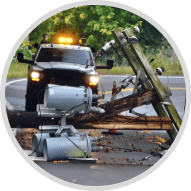

Change is the only constant, and our climate is no different. Throughout history, glaciers have both advanced and retreated, asteroid debris created months of darkness and tropical climates once blanketed Greenland.* But today, we’re in a pattern of gradual warming.
Since the late 19th century, our global temperature has risen 2.12 degrees Fahrenheit, driven by an increase in carbon dioxide emissions.* Extreme weather that was once rare — destructive wildfires, violent heatwaves, torrential rains and devastating hurricanes — is now becoming commonplace.
From coast to coast, these severe weather events are pushing aging utility networks beyond their limits. The result is widespread power outages that are lasting longer and longer.
Five years ago, the average American homeowner endured less than four hours per year without power. In 2021, that length of time soared to an average of seven hours.*

Downed Lines
Winter storms, downed power lines and blackouts — that’s what many of us think about when there is severe weather. And this is a big factor when it comes to weather-related outages. Heavy precipitation can cause ice and snow to build up on tree branches, tumbling on power lines and structures. Gusts of wind can knock trees into power lines and knock down poles, causing a localized outage.

Equipment Failure
The infrastructure used to generate, transmit and distribute energy are constantly exposed to the elements. These can also fail in several ways. Extreme temperatures can shut down operations if the components of a power plant freeze. Severe weather can also hinder fuel production and transportation if wells get so cold they can’t produce and gas lines freeze. High winds can damage old equipment in a single gust, and even create a spark that causes a wildfire.

Overloaded Grid
During a heat wave, more people use their AC throughout the day and night, which can overwhelm the grid. Transmission lines have a lower capacity in hot weather, so an increased demand causes the lines to droop and even short-circuit. Heavy rain can damage power equipment, while mudslides make it challenging to access broken components, prolonging outages.
To prevent major damage during severe weather events, utility companies may need to shut equipment down, causing interruptions to specific areas. In fact, cutting power is a tactic that’s becoming more common.

Safety Shutoffs
To help prevent wildfires during periods of dry and windy weather, PG&E began implementing public safety power shutoffs (PSPS) in 2019. During severe weather, these planned power outages “deenergize” the electric grid, and crews inspect equipment before restoring power.*

Undergrounding Lines
Burying power lines is a popular idea, and it seems like a practical solution for weatherproofing. But building subterranean electrical systems takes time and money — we’re talking decades and billions of dollars.* Some of that cost would be passed along to ratepayers. With many people struggling to pay utility bills as it is, this solution becomes prohibitively expensive. Underground power lines would still be subject to flood damage and their location would make it challenging to identify problems and access the equipment to make repairs.*

Improving Resiliency
Rather than investing resources in burying lines, many power companies are focusing on making their systems more resilient to extreme weather. One example is allowing the cables to drop the instant a problem arises, which prevents a domino effect of multiple poles collapsing. Designing lines to fail at specific points also reduces the repair time, as evidenced by Hurricane Irma in 2017: power was restored in hours compared to weeks following Hurricane Wilma 12 years prior.* But despite growing investments by utility companies, power grids remain fragile.
The Cost of More Frequent Power Outages

Electric outages don’t just force us to unplug and enjoy a peaceful evening by the fire. Outages lasting more than a few hours can close businesses, shut down schools, delay emergency services and disrupt supply chains.
In any given year, severe weather-related interruptions cost utility customers $2-$3 billion.* How does that break down per residence?
A survey by Briggs & Stratton found that the cost of a power outage for the average household that suffered mild property damage (basement flooding and sump pump repair) was around $1,900.*
For those who experienced an outage in the past two years, the most common costs were:
Replacing
Spoiled Food
Purchasing
Supplies
Hotel
Stays
Lost Wages
From Work
Adding to this are soaring natural gas prices that increase electricity costs and affect a number of other sectors, from agriculture to manufacturing.
Improving Your Home’s Resiliency to Keep You Safe

Lengthy power outages aren’t just an inconvenience. The historic deep freeze in Texas claimed the lives of nearly 250 vulnerable residents when the power grid failed and left 4 million people without electricity for days.* Without immediate solutions for our nation’s aging infrastructure and a climate that continues to stress the grid, many fear these tragedies will become more common.
So, what can you do to protect your home and keep you and your family safe?
It’s clear that the most practical solutions from utility companies are focused on restoring power quickly, not preventing grid failure. Losing electricity for a day is certainly better than a week, but residents must still plan for electrical outages, as they’re becoming the norm.
Disaster preparation never seems like a top priority until you’re in the midst of mayhem. Abrupt, weather-related outages happen without warning, and planned shutoffs give you just enough time to gather basic supplies. By preparing for outages long beforehand with solar and battery backup power, you can ensure your home has a reliable source of energy during a grid failure.
Sunnova’s Commitment to Energy Independence
At Sunnova, we believe everyone should have the freedom to live life uninterrupted. We imagine a world where you can use the energy you need, when you need it, how you need it — regardless of how the electric grid is performing or the weather outside your window. Our team is focused on powering energy independence and developing the most effective ways to bring reliable energy to you, your family, and your community.


New to solar?
Sunnova’s SunSafe® solar + battery storage service allows you to pair home solar panels with backup power. By creating and storing your own power, you can take control over your home energy, and worry less about inclement weather or power safety shutoffs.

Already have a solar system?
Sunnova’s +SunSafe® add-on battery service lets you install battery backup to an existing home solar system, regardless of whether you purchased it from Sunnova or another solar provider. Solar battery backup offers an eco-friendly alternative to noisy, portable generators that guzzle gasoline outside your home. Gas can be scarce during a disaster, and your emergency generator may only run for a few hours before it’s empty. With no fuel needed, Sunnova’s home battery storage option provides consistent power during the day or night.*

Live in California?
If you’re a California homeowner and live in an area prone to wildfire, mudslides, rolling blackouts or other grid interruptions, solar with battery backup is the solution for energy resiliency. This way, you can continue working from home, cooking meals, running your forced-air furnace, watching the news and operating medical equipment like oxygen devices.*

